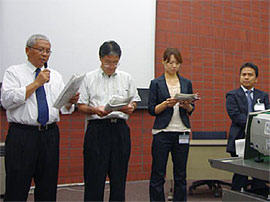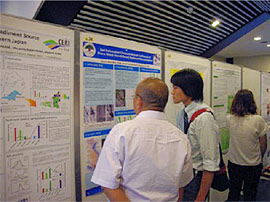Three keynote lectures were given after the opening ceremony: Mr. Ugyen Wangda of the Geological Survey of Bhutan, Department of Geology and Mines, Ministry of Economic Affairs, Thimphu, Bhutan talked about "Sediment Disasters and Associated Landslides in Bhutan"; Dr. Ranjan Kumar Dahal of the Department of Geology, Tri-Chandra Campus, Tribhuvan University, Ghantaghar, Kathmandu, Nepal lectured on "Rainfall-Induced Landslides in Nepal"; and Dr. David Higgitt of the Department of Geography, National University of Singapore talked about "Large Rivers and Sediment Cascades: Connectivity and Discontinuity." All these presentations gave detailed introductions of research on landslide hazards and movements and conditions of sediment in Asia, and they were very interesting. There were animated lectures and Q&A sessions that went beyond the scheduled time.
Poster presentations were held in five sessions in the afternoon program. The titles of each session and the number of presentations are as follows: Erosion prevention in volcanos (3); Slope failures and landslides (9); Sheet erosion (6); Hydrology and sediment discharge (11); and Measurement and management (3). The total number of presentations was 32. Participants voted in the poster award session during the presentation. In the one-minute slot to emphasize the good points of the presentation, the presenters took turns to describe the contents of their presentations in one minute in front of all participants in the conference room (Photo 1). This allowed all participants to look at the faces of presenters and hear about their posters in a short time. One-hour core time was provided after the speech, and participants engaged in animated discussions (Photo 2). Based on the votes casted by participants, one Best Poster Award and two Excellent Poster Awards were given to the winners.
A workshop named "Advances in new and traditional techniques and methodology on sediment dynamics" was held as the second part of the afternoon program. After Mr. Shigeru Mizugaki of the Civil Engineering Research Institute for Cold Region gave an overview, three young researchers who had recently gained their degrees proposed topics: Mr. Thomas Parkner of the University of Tsukuba talked about the "Current state of gully erosion research in steep catchments of Asian-Pacific regions"; Norifumi Hotta of the University of Tsukuba discussed "Long-term fluctuations in sediment discharge from mountain basins after huge landslides"; and Mr. Ronald De Rose of Hokkaido University talked about "Scale and modeling in catchment science." All presenters introduced outcomes of investigations and analyses involving different phenomena and methodologies filled with interesting topics. The presentations indicated a variety of possible directions in which future research could head regarding the movement of landslides in catchment scales.
Then, five presentations were given by graduate students who will be leaders in the next generation in the pop-up session. Mr. Hiroaki Izumiyama and Mr. Puji Harsanto of Kyoto University and Mr. Kenichi Koshimizu, Mr. Ayumi Miyamoto, and Mr. Hidekazu Igarashi of Hokkaido University gave concise presentations on the characteristics and advantages and disadvantages of the methodology of research they were conducting. Since this symposium did not have an oral presentation session, the pop-up session provided a good opportunity for these students to give oral presentations in front of all the participants.
A poster award ceremony was held in the closing ceremony. Mr. Masakazu Suzuki, chairman of the Japan Society of Erosion Control Engineering and chairman of the Steering Committee, presented honorary certificates to the winners. The Best Poster Award was given to "Fingerprinting suspended sediment source in the Nukabira River" by Mr. Shigeru Mizugaki et al. of the Civil Engineering Research Institute for Cold Region. Excellent Poster Awards were given to "Continuous monitoring of the 2011 eruption of Shinmoedake Volcano, Kirishima Volcanic Group, Japan, using RADARSAT-2" by Mr. Hisashi Sasaki et al. of Kokusai Kogyo and "The landslide movement process at Shiao Lin Village during Typhoon Morakot" by Mr. Yuan-Jung Tsai et al. of the Department of Hydraulic and Ocean Engineering, National Cheng-Kung University, Tainan.

